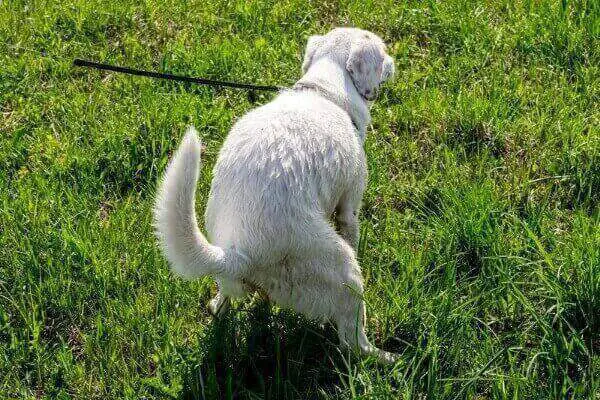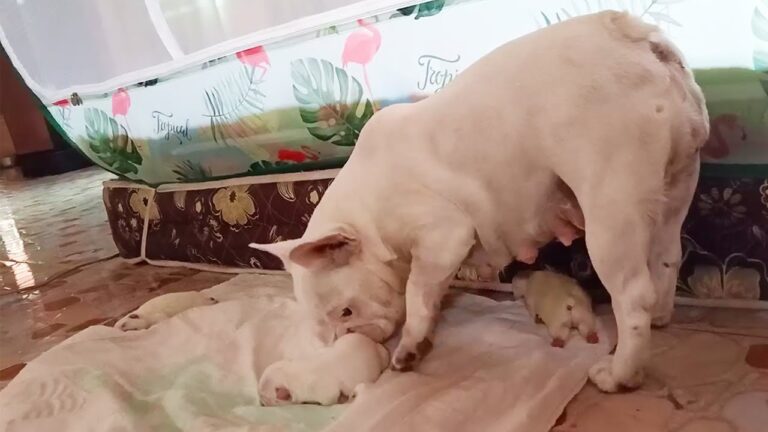Help! My Dog Ate Panty Liner: What Should I Do? (Vet Answer)

Dogs sometimes have a certain curiosity and knack for getting into things they shouldn’t. One day, it could be your favorite pair of shoes, and the next day, it could be a pack of panty liners. Although your pooch might have gotten away with this in the past, the ingestion of foreign objects such as panty liners can pose serious health risks to our canine companions. Therefore, it’s vital to act promptly and correctly should you ever find yourself facing this situation.
When you discover that your dog has ingested panty liners, the first step is to ensure your dog’s immediate safety by removing any remaining liners from its reach. This should be followed by gathering all the necessary information for your vet. The time of ingestion, quantity swallowed, the type and material of the panty liner, presence of symptoms, and, and current health status are all essential for your vet to make informed decisions about the treatment course.
Once this information is at hand, reach out to your veterinarian immediately. Even if your dog seems fine, panty liners aren’t designed to be ingested and could lead to serious complications.
The purpose of this article is to provide you with a comprehensive guide to handling such situations and shed light on the potential dangers, symptoms to watch out for, and why dogs might engage in such behavior.
Jump to Section
What Should I Do If I Dog Ate Panty Liner?
When our canine companions get into things they shouldn’t, like panty liners, it’s vital to act promptly and correctly. Should you ever find yourself facing this situation, here’s a comprehensive step-by-step guide on how to handle it.
1. Move The Panty Liner Away From Your Dog
First and foremost, remove any remaining panty liners from your dog’s reach to prevent further ingestion. Your dog may not understand the risk associated with consuming these items and might try to eat more if given the chance.
If you catch your dog in the act and see that they still have some of the material in their mouth, you can carefully try to remove it. Be gentle and cautious, as dogs can instinctively snap or bite when you reach into their mouths. Never attempt this if you believe your dog may bite or if it causes them distress.
To prevent future incidents, rethink where you store your sanitary products. Keep them in a secure, closed cabinet, out of your dog’s reach, or consider using a dog-proof trash can.
2. Gather All Necessary Information
The quality of information you can provide to your vet greatly influences their ability to evaluate the situation and decide on the best course of action. Here are some key details you should gather:
Time of Ingestion: Try to establish as accurately as possible when your dog ingested the panty liner. This information helps set a timeline for potential symptoms and guides the vet in determining the right treatment course.
Quantity Swallowed: Do your best to estimate how many panty liners your dog may have consumed. Look for remnants of torn packaging or parts of the liners themselves. The quantity ingested is critical, as it could significantly impact the severity of your dog’s condition.
Type and Material of the Panty Liner: Panty liners come in various types and can be made from different materials. Try to provide your vet with this information if possible. Is the liner scented? Is it made of cotton, or does it have a plastic layer? This information may affect how your dog’s body reacts to the foreign object and influence the approach your vet takes for treatment.
Presence of Troubling Symptoms: Note any changes in your dog’s behavior or any symptoms that have appeared since the ingestion. This can include choking, vomiting, loss of appetite, constipation, lethargy, or signs of distress. If your dog appears normal, that’s important to note too.
Dog’s Weight and Age: Your pet’s weight and age are crucial factors that can influence how their body handles the ingested material. For instance, a smaller or younger dog may face more severe complications than a larger, fully grown one due to the relative size of the ingested item.
Current Health Status and Medications: Be prepared to provide information about your pet’s general health status, including any existing medical conditions and medications they might be currently taking. This information can help the vet understand any potential complications or interactions.
Remember, even if you think a detail might be insignificant, it’s always better to err on the side of caution and provide your vet with as much information as possible. This will help them make the best possible decisions for your pet’s care.
3. Call Your Vet
Once you’ve gathered all the necessary information, contact your veterinarian immediately. This step is essential, even if your dog seems fine. Panty liners aren’t designed to be ingested and could lead to serious complications, such as choking, gastrointestinal obstruction, or injuries.
Relay all the collected information to your vet as mentioned above. Based on this information, your vet can then provide advice on the next steps. Do not try to induce without the vet’s supervision.
In some cases, your vet might advise you to bring your dog in for a check-up. If the panty liner has caused an obstruction, your dog might require further diagnostic tests such as an x-ray or ultrasound, and potentially, surgical intervention.
Potential Dangers Of Eating Panty Liners In Dogs
While panty liners are not inherently toxic to dogs, ingestion can lead to several serious complications that pose a significant threat to your pet’s health. Dogs do not discriminate much when it comes to what they put in their mouths, and unfortunately, this can often lead to dangerous situations. Understanding the potential hazards can help pet owners recognize and respond to these situations effectively.
1. GI Obstruction
One of the most significant risks associated with dogs eating panty liners is the potential for gastrointestinal (GI) obstruction. This condition occurs when the panty liner gets lodged in the dog’s gastrointestinal tract, preventing the normal passage of food and fluids.
A GI obstruction can cause a host of unpleasant symptoms, including vomiting, loss of appetite, abdominal pain, constipation, or diarrhea. If not promptly addressed, it can lead to serious complications such as damage to the intestinal walls, infection, or in severe cases, rupture of the intestine, which is a life-threatening situation requiring immediate surgical intervention.
2. Choking
Choking is another immediate danger when dogs ingest non-food items like panty liners. The panty liner, especially if swallowed whole or in large pieces, can get lodged in your dog’s throat, obstructing airflow.
Symptoms of choking in dogs include panicked behavior, excessive drooling, difficulty breathing, and pawing at the mouth. This situation is a medical emergency requiring immediate intervention to remove the obstruction and restore normal breathing.
3. Digestive Injuries
Even if the panty liner passes through the digestive tract without causing an obstruction, it can still potentially cause damage. The material of the panty liner may be rough or sharp, leading to scratches or tears in the esophagus, stomach, or intestines. This can cause inflammation, bleeding, and pain.
Furthermore, the body’s attempt to pass the foreign object can cause excessive strain on the digestive system, potentially leading to conditions such as gastritis or colitis, which are inflammations of the stomach and colon respectively.
4. Infections
Used panty liners carry an added risk of causing infections. The presence of human bodily fluids can introduce bacteria and other pathogens into your dog’s system. This can lead to various infections, with symptoms ranging from mild gastrointestinal upset to more severe systemic infections, which can be potentially life-threatening if not promptly treated.
Given these risks, it’s essential to keep panty liners out of your dog’s reach and to consult with a veterinarian immediately if you suspect your dog has ingested a panty liner.
Can Dogs Digest Or Pass A Panty Liner?
The dog’s digestive system is not equipped to handle the materials used in panty liners. Unlike certain types of foods, panty liners are not designed to be broken down in the digestive tract. They’re typically made of materials like cotton, rayon, or even with a plastic layer- none of which can be processed by the enzymes in your dog’s stomach.
Therefore, it’s unlikely that your dog will be able to fully digest a panty liner. However, depending on the size of the liner and how much your dog chewed it up before swallowing, it may be broken down into smaller pieces in the stomach.
As for whether your dog can pass a panty liner, this depends largely on the size of your dog and the size and quantity of the liners they’ve ingested. For smaller dogs, or if a large amount of material was consumed, the risk of gastrointestinal obstruction is high. This can prevent the liner from passing naturally and may require medical intervention.
For larger dogs, or if only a small amount of material was ingested, the liner or pieces of it may be able to pass through the dog’s digestive system. However, this process could still potentially cause discomfort or damage, such as scratches or tears in the digestive tract, as the liner makes its way through. It could take anywhere from 10 to 48 hours for the liner to pass, but this time frame can be longer depending on the individual dog and the circumstances.
Symptoms Associated With Eating Panty Liners
Whether your dog is presenting with troubling symptoms or not, you should still reach out to your vet. The ingestion of a panty liner by a dog can lead to various symptoms. Some dogs might show immediate signs of discomfort, while others may not show symptoms for a few hours or even a day or two after ingestion. It’s also possible for dogs to not show any symptoms especially if they consumed only a little quantity.
Here are some of the most common symptoms associated with dogs eating panty liners:
Vomiting: This is a very likely symptom you’ll notice in this case. The body might attempt to expel the foreign object through vomiting.
Loss of Appetite: Your dog might lose interest in food due to discomfort in the digestive tract.
Constipation: If the liner is causing an obstruction, your dog might become constipated.
Abdominal Pain: Your dog might show signs of discomfort when you touch his abdomen.
Lethargy: Dogs might become less active due to discomfort or pain. They might also sleep more than usual.
Pacing or Restlessness: Some dogs may show signs of restlessness, such as pacing or being unable to settle down, due to discomfort or distress.
Difficulty Breathing: If the panty liner becomes lodged in the windpipe, the dog might have trouble breathing. Smaller dogs are more prone to choking.
Why Does My Dog Eat My Pant Liners?
Dogs can’t tell what might be harmful to their health and you may find the mouthing or eating foreign objects and this can be concerning especially when excessive. More specifically, delve into the reasons why dogs might engage in eating your liners.
Curiosity and Exploration
Dogs, particularly puppies, explore the world around them through their mouth. Chewing is a natural behavior for dogs, and they often chew on things to investigate them. This means that almost any object within reach can become a chew toy – including panty liners. In other words, your dog might not be eating the panty liner so much as chewing on it and accidentally ingesting it in the process.
Scents and Tastes
To us, a used panty liner might seem like the last thing anyone would want to get into, but for dogs, the situation is different. Dogs have an extraordinary sense of smell – far superior to ours – and can be attracted to the unique scents on used panty liners. These scents, linked to human hormones and bodily fluids, can be intriguing or even appetizing to a dog.
Boredom or Anxiety
Some dogs might turn to inappropriate chewing or eating behaviors out of boredom or anxiety. If your dog doesn’t have enough physical and mental stimulation, he might start getting into things they shouldn’t like your panty liners. Similarly, some dogs might chew or eat non-food items as a way of coping with anxiety or stress.
Pica
Pica is a condition characterized by the ingestion of non-food items. It can occur in dogs just like in humans, and it can lead to the consumption of a variety of objects, including panty liners. Pica can be caused by various factors, including dietary deficiencies, brain disorders, or behavioral issues.
Practical Tips To Keep Your Dogs Away From Your Sanitary Products
Ensuring that your furry friends do not have access to sanitary products is an essential part of pet-proofing your home. Below are some practical tips to help keep your dogs away from these items:
Store Products Securely
One of the most straightforward ways to prevent your dog from getting into your sanitary products is to store them securely. Consider keeping these items in a closed cabinet or drawer that’s out of your dog’s reach. If your dog is a particularly determined chewer, you may want to invest in child-proof locks for your cabinets.
If you’re disposing of used sanitary products in a trash can, ensure it’s pet-proof options. Dogs can be surprisingly good at foraging through trash bins, especially when enticed by intriguing smells. Pet-proof trash cans are designed to be secure and harder for pets to access. They often come with tight-fitting lids or lock mechanisms to deter even the most persistent dogs. This ensures that your furry friend cannot get to the discarded panty liners, keeping them safe and your bathroom clean.
Keep Bathroom Doors Closed
Make it a habit to keep bathroom doors closed when they’re not in use. This simple action can prevent your dog from gaining access to the waste bin and any sanitary products stored in the bathroom.
Provide Plenty of Suitable Chew Toys
Often, dogs get into things they shouldn’t because they’re bored and looking for something to chew on. Make sure your dog has plenty of appropriate chew toys to keep them occupied. This can help redirect their chewing behavior onto suitable objects and away from things like panty liners.
Train Your Dog
Training can also be an effective way to keep your dog away from your sanitary products. Commands like “leave it” or “drop it” can be especially useful in these situations. Consider working with a professional dog trainer if you’re not confident in training your dog yourself.
Monitor Your Dog
Finally, monitor your dog, especially if you know they have a history of getting into sanitary products. Pay attention to where your dog goes and what they’re doing, especially when they’re in areas where sanitary products are stored or disposed of.
Final Thoughts
Dogs are naturally curious creatures, which sometimes leads them to act strangely – from harmful behaviors like nudging their bowls before eating to ingest things they shouldn’t – including panty liners. While these items may seem harmless, they pose significant health risks to our furry friends. They can lead to choking, gastrointestinal obstruction, digestive injuries, and in the case of used liners, even infections. The dangers underscore the importance of pet-proofing your home and keeping such items out of your dog’s reach.
If your dog does ingest a panty liner, it’s critical to act promptly. Remember to keep calm, assess the situation, gather all the necessary information, and reach out to your veterinarian immediately. Look out for any symptoms such as vomiting, loss of appetite, changes in bowel movements, or any sign of distress, which could indicate potential complications.
In the grand scheme of things, prevention is always better than cure. Ensure that you provide ample chew toys for your pet to satisfy their chewing habits and consider training them to understand commands like “leave it” or “drop it.” Keep all sanitary products out of your pet’s reach and dispose of used items in pet-proof bins. Let’s do all we can to keep our furry friends safe, healthy, and happy. After all, their well-being is always worth the effort.





